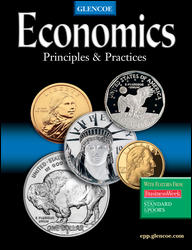
Economics Principles & PracticesChapter 9: Sources of Government RevenueChapter OverviewsChapter 9 explores the sources of government revenue. Each year governments raise billions of dollars in revenues in a variety of ways, including taxes, license fees, tuition fees, and customs duties, to name just a few. Section 1 explains three criteria—equity, simplicity, and efficiency—used to judge the effectiveness of a tax. The benefit principle of taxation and the ability-to-pay principle of taxation are used to help decide the group or groups that should bear the burden of the tax. Taxes are proportional, progressive, and regressive, depending on the way the average tax per dollar changes as taxable income changes. Section 2 discusses the main sources of federal government revenues. The first is the individual income tax, a progressive tax administered through a payroll withholding system. The second largest component is FICA. The corporate income tax is the third largest source. Other sources of federal revenue include excise taxes, estate taxes, gift taxes, customs duties, and user fees. Section 3 explains how state governments receive revenues in the form of sales taxes, intergovernmental revenues, individual income taxes, and employee retirement contributions. Local governments receive funds from state and federal governments, property taxes, utility and liquor stores, sales taxes, and other sources. Section 4 discusses additional tax issues such as the incidence of a tax, the value added tax, and tax reform. There have been four major tax revision bills since 1980. The first reduced the progressiveness of the individual income tax and the second made it more proportional. The third, passed in 1993, made it more progressive again. The fourth, passed in 1997, provided wealthy individuals with significant tax relief for long-term investments, and provided modest tax relief for child and educational expenses. Recent talk of tax reform has centered around a Value Added Tax (VAT), which is a tax on consumption rather than income, and a flat tax, which would replace all tax brackets with a single tax rate. |  |















